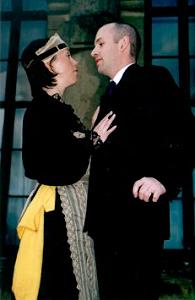|
<< -- 2 -- David Thompson WAITING FOR FIGARO

So poor old Bampton is fobbed off with Lo Sposo Deluso (The
Deluded Bridegroom).
Nil desperandum! We'll get on with rehearsing that. And so The
Deluded Bridegroom is brought to the stage, albeit in rehearsal. Fine.
But there's another problem: four glorious musical numbers, (and they
are), do not an opera make. But what's this at the bottom of the parcel?
Yes, you've guessed: L' Oca del Cairo (The Cairo Goose).
End of part 1. Rehearsal over, operatic politics as much resolved as may
be, to the concluding numbers of The Impresario. Part 2: a fully-staged
performance of The Cairo Goose. Result: a full evening of rare Mozart.
What we were given was much, much more than a tantalising series of Mozart's
abandoned offcuts; we were treated to a rich and credible operatic entertainment,
and a deep insight into the creative mind of a genius.
In the revised scenario, the producers and company are 'waiting for Figaro'.
In his own creative 1780s development, Mozart was also waiting for Figaro,
or, rather, the polished ingenuity of a Da Ponte libretto to liberate his
greatest inspirations. In the meantime, though, in these miniatures and
fragments, we can glimpse the detail of his period of gestation and experience
the journey of his work in progress.
What stands out most of all is the marvel of Mozart's characterisation
and ensemble writing, so manifest in Figaro itself, of course, but
often raised to a comparable level in these little-known scores. The finale
of this surviving act of L'Oca, for example, is a marvel of
intricacy and interaction of character, and there are several character
studies that can be readily identified in their later and finished perfection
in the Da Ponte operas. The early duet of the lovers, Chichibio and Auretta
in L'Oca has Figaro and Susanna written all over it in musical
style and interaction of character. What a tragedy that Mozart never saw
fit to complete this tantalising work, with such a brilliant and performable
act already virtually finished in all but the details of orchestration.
Here, Erik Smith's seamless reconstruction was used.

Auretta (Amanda Pitt) and Chichibio (Thomas Guthrie) in 'Waiting for Figaro'. Photo © Gilly French
|
The four surviving pieces of Lo Sposo are equally fine in themselves,
but, of course much more difficult to perform credibly on stage. The overture,
conceived in the manner of that to Die Entführung (fast-slow-fast
with a direct link into the first vocal number), is a marvellous piece,
with an absolutely ravishing slow central section in triple time. Buried
treasure indeed.
Continue >>
Copyright © 20 September 2002
David Thompson, Eastwood, Essex, UK

|

